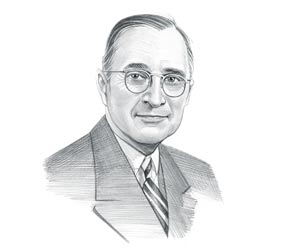|
|
|
|
|
Containment was the policy of restricting communist expansion by diplomatic, military and economic actions. The Truman Doctrine warned that it was the duty of the United States to quash the communist aggression in Turkey and Greece. The purpose of the Truman Doctrine were to ease the USSR demands in Turkey and to stabilize the government in Greece to prevent the spread of communism.
What was
the Truman Doctrine? Doctrine Definition
for kids Facts about
Truman Doctrine The United States had become increasingly alarmed at the rising power of the USSR and the spread of Communism in the countries behind the Iron Curtain Not content with their influence over the communist-dominated governments in the 'Satellite Nations' of East Germany, Bulgaria, Czechoslovakia, Hungary, Poland, Romania and Albania, the USSR sought to extend their power and communism to other countries in Eastern Europe and the Middle East. Two of the Soviet's targets were Turkey and Greece. The Soviet takeover of many of the countries of eastern Europe was achieved using ‘salami tactics’. Salami tactics, or the 'salami-slice strategy', used a divide and conquer process of alliances and threats to overcome opposition. The USSR were adopting the strategy of ‘salami tactics’ in order to dominate Eastern Europe, piece by piece. Greece was one of the few countries in Eastern Europe that had not turned communist. The Greek Civil War (1946–1949) had erupted and the Communist rebels in Greece were only prevented from taking over the country by the British Army. Turkey was involved in the Turkish Straits crisis. Following WW2 Turkey was being pressurized by the Soviet government for joint control of the sea ports of the Dardanelles and allow Russian shipping to flow freely through the Turkish Straits. The Turkish Straits, which connected the Black Sea to the Mediterranean, were not only extremely important trade route but were also critical in terms of the Soviet military strategy. Whoever controlled of traffic through the Turkish straits could use them as an exit or entry points for naval forces to travel to and from the Black Sea. The British were experiencing serious financial difficulties following WW2 and could no longer afford the expense of providing military aid. The Truman Doctrine responded to the crisis in Greece. On March 27, 1947 President Harry Truman asked Congress to support the Greek Government with military and economic assistance against the Communists. He also asked Congress to provide assistance for Turkey to help them resist the communist threat. A victory for the Communists in the Greek Civil War would in turn endanger the political stability of its near neighbors Turkey and undermine the political stability of the Middle East. The Middle East was of immense strategic importance to US national security and Truman believed it was imperative for America to intervene. The president requested Congress to provide financial aid to both the Greek and Turkish Governments and to support the dispatch of American civilian and military personnel and equipment to the regions. The Truman Doctrine stated that the United States would support "free peoples who are resisting attempted subjugation by armed minorities or by outside pressures." The US policy of Containment was a key element of the Truman Doctrine, in fact the president's address to Congress is also known as ‘Truman’s containment speech’. The policy of containment aimed at restricting Soviet expansion by keeping communism within its present territory by diplomatic, military and economic actions. The President cautioned Congress that it was the duty of the United States to quash the communist aggression in Turkey and Greece. The Truman Doctrine was of immense importance in the Cold War and it set out many of its principles. The Cold War was defined as a conflict between good and bad, and a choice between communism or capitalism, dictatorship or democracy, and freedom or oppression. The President's speech became known as the Truman Doctrine and heralded an important change in American foreign policy. The Truman Doctrine completely overturned the Monroe Doctrine which had advocated the principle of neutrality and had been the major influence over US government and foreign policy since 1823. The Truman Doctrine gave rise to the Domino Theory which related to the spread of communist rule during the Cold War. The Domino theory speculated that if one area came under the influence of communism, then the surrounding countries would follow in a crashing domino effect. The Truman Doctrine led directly to the Marshall Plan which was ratified by Congress in 1948. The Marshall Plan can be termed as the "Truman Doctrine- Phase II". The Truman Doctrine had no specific policy for other regions, like the Middle East or Asiaand this omission was addressed in the Eisenhower Doctrine in 1957. |
| US American History |
| 1945-1993: Cold War Era |
|
|
|
|
|
First Published2016-04-19 | |||
|
Updated 2018-01-01 |
Publisher
Siteseen Limited
| ||
|
|

